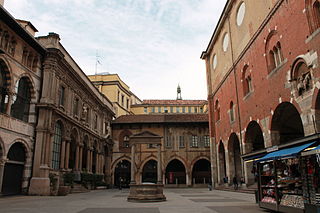History and description
The original palace was built in the early years of the 15th century by the Visconti, who used it as a second-rate residence, having at their disposal larger and more sumptuous ones. In fact, as early as 1415, it was donated by Filippo Maria Visconti, Duke of Milan, to Carmagnola, a famous condottiere of the time, who undertook its radical renovation between 1420 and 1425. On his death by beheading in Venice in 1432, the palace was inherited by his daughters; here in 1465 was held the ceremony with which Genoa lent total dedication to Francesco Sforza, in an anti Savoia key. Lodovico il Moro already claimed ownership of it in the last years of the 15th century: he obtained it by confiscation, forfeiting it as regalia, after the death of Pietro II Dal Verme, who in turn had received it as an inheritance from his mother Luchina Bussone, daughter of Carmagnola. In those years the palace underwent major renovation works, which saw its completion with fine colonnades very similar to those of the Monastery of Santa Maria del Lentasio and its transfer, in 1497, to the mistress of Duca Cecilia Gallerani. Under his supervision, both Bramante and Leonardo took part in the embellishment of the palace, to whom is also attributable the peculiar sundial designed in the ground of the second courtyard. [1]
With the entry of the French into Milan, the palace passed into the hands of the latter; in 1505 it was sold by Carlo d’Amboise, French Governor of Milan, to Francesco Bebulco, master of the ordinary revenues. From 1605, it also served as the public granary. In 1714 some premises were readapted to house the offices of the Banco di Sant'Ambrogio; new works were started from 1770, to adapt the structure to house the Civic Archives, directed by the historian Giorgio Giulini. In 1773 the Tribunale di Provvisione was also transferred here from Piazza Mercanti. In 1786 it became the Broletto Novissimo]], i.e. the municipal seat of the municipality of Milan, replacing the Broletto Nuovo. [2]
In Napoleonic era it housed the Departmental Prefecture, when new renovations were undertaken. With the Unification of Italy, in 1861 there was a swap between the Municipality and the State, which saw an exchange between Palazzo Marino and Palazzo Carmagnola: the former now became the municipal seat, chosen both for a question of space and for a question of prestige and significance, [3] the second came to house the offices of the Demanio, undergoing further remodelling and adaptation. Between 1890 and 1893, in conjunction with the construction of Via Dante, the body of the building overlooking Via Rovello was rebuilt, with the façade being rebuilt, taking particular care not to excessively alter the appearance of the main courtyard, which was in any case amputated. From 1910, the year of the demolition of the former Monastero del Bocchetto, it also housed the Stamp and Registry Office, previously located in the former religious structure.
Between 1927 and 1931, an agreement between the City and the State sanctioned the return of Palazzo Carmagnola to the property of the City of Milan. From 1937, new restoration work and adaptations were carried out on the structure, so that it could house the recreation rooms of the Municipality’s employees' recreation centre. During that period, the basement of the building was also used as the headquarters of the fascist regime's counter-espionage services. Starting from 1943, the Legione Muti, commanded by Francesco Colombo, settled there instead (until 26 April 1945. In 1947 the building was adapted by Ernesto Nathan Rogers and Marco Zanuso to house the headquarters of the Piccolo Teatro di Milano, founded that same year by Paolo Grassi and Giorgio Strehler. Some municipal offices are still located on the upper floors, as they were then.
All that remains of the 15th-century building are the porticoes of one of the two courtyards, with their capitals sculpted in marble, while the six-arched porticoed courtyard is already the work of a reconstruction attributable to the early 16th century. During the last recent restoration, frescoes from the end of the 15th century were brought to light that can be attributed to the work of Bramante and Leonardo da Vinci. [4]

The Castello Sforzesco is a medieval fortification located in Milan, Northern Italy. It was built in the 15th century by Francesco Sforza, Duke of Milan, on the remnants of a 14th-century fortification. Later renovated and enlarged, in the 16th and 17th centuries it was one of the largest citadels in Europe. Extensively rebuilt by Luca Beltrami in 1891–1905, it now houses several of the city's museums and art collections.

Villas and palaces in Milan are used to indicate public and private buildings in Milan of particular artistic and architectural value. Milan has always been an important centre with regard to the construction of historical villas and palaces, ranging from the Romanesque to the neo-Gothic, from Baroque to Rococo.
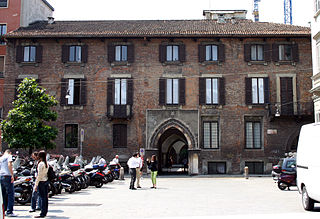
Palazzo Borromeo is a 13th-century building located at street #12 of Piazza Borromeo in Milan, region of Lombardy, Italy,. It stands across a small piazza from the church of Santa Maria Podone and a statue dedicated to the 16th-century archbishop and cardinal, St Charles Borromeo.

Casa Panigarola, also known as Palazzo dei Notai, is a historic building of Milan, Italy, located in Piazza Mercanti, former city centre in the Middle Ages. It is named after the House of Panigarola, a family of notaries from Gallarate, that owned the building until 1741. The building thus served as a notary seat, and the activities therein were strictly related to those that occurred in the adjacent Palazzo della Ragione, where trials were held.

The Palazzo delle Scuole Palatine is a historic building of Milan, Italy, located in Piazza Mercanti, the former city centre in the Middle Ages. It served as the seat of the most prestigious higher school of medieval Milan. Many notable Milanese scholars of different ages studied or taught in these schools; Augustine of Hippo and Cesare Beccaria, among others, served as teachers in the Palatine. The current building dates back to 1644, when it replaced an older one, which had the same function and was destroyed by a fire.

The Palazzo Anguissola or Anguissola Traversi is a palace located at Via Manzoni number 10, in central Milan, a city in the northern Italy. Construction began in 1778, and its Neoclassical facade, designed by Luigi Canonica, was added in 1829.

The Palazzo Tarsis is an 18th-century mansion in Milan, northern Italy, built in the Neoclassical style. Its interiors were fully renovated after the building was bombed in 1943. Historically part of the Porta Nuova district, it is located at 1, Via San Paolo.

Palazzo Arese was a 16th century baroque palace and seat of a branch of the House of Arese in Milan, Italy. It was located adjacent to Casa Fontana Silvestri near the Porta Orientale. The palazzo was demolished in 1943 following damage sustained during the bombing of Milan in World War II.

Palazzo Mezzabarba is a palace in Pavia, Lombardy, a notable example of Lombard rococo, It has been Pavia's city hall since 1875.
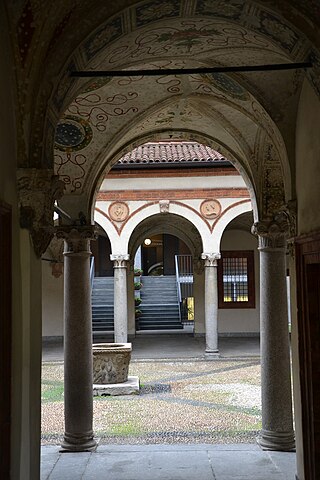
The Palazzo Dal Verme was the noble residence of one of the most powerful families of the Visconti and Sforza court in the 15th century. The courtyard remains today, one of the greatest examples of civil construction from the Renaissance era in Milan. It is located at 3 Via Giacomo Puccini.

The Palazzo del Monte di Pietà is a 15th-century palazzo in Milan, Italy, adapted in a neoclassical style in the 18th century by Giuseppe Piermarini. Historically belonging to the Sestiere di Porta Nuova, it is located in Via Monte di Pietà no. 5, and was the seat of the Monte di Pietà di Milano.

The Palazzo di Prospero Visconti' is a 16th-century palace in Milan. Historically belonging to the sestiere di Porta Ticinese, it is located in via Lanzone 2, in the ancient contrada del Torchio no. 2,919.

Palazzo Isimbardi, also palazzo della Provincia, is a historic building in Milan located at 35 Corso Monforte, the seat of the Metropolitan City of Milan.
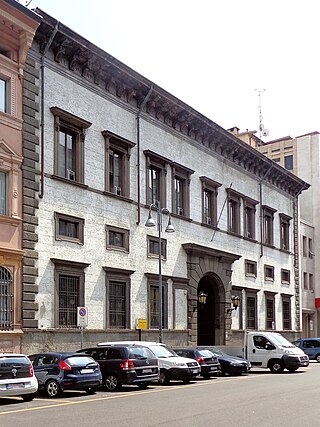
Palazzo Spinola is a 16th-century palazzo in Milan, heavily remodelled during the 19th century. Historically belonging to the sestiere di Porta Nuova, it is located at 10 Via San Paolo. Since 1808 it has been the seat of the Garden Society.

Palazzo Visconti di Grazzano, also known as Palazzo Visconti di Modrone or Palazzo Bolagnos, is a historical palace located in the centre of Milan, in Via Cino del Duca no. 8.
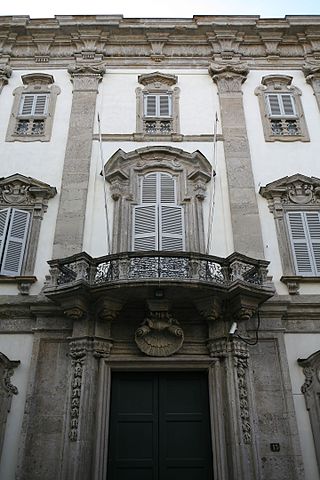
Palazzo Cusani is a 17th-century palace in Milano, remodelled a first time between 1712 and 1719 and a second time between 1775 and 1779. Historically belonging to the sestiere of Porta Nuova, it is located at via Brera 13–15.

Casa Atellani, or also Casa degli Atellani, is a demorial that belonged to Ludovico Sforza, Duke of Milan, the last surviving trace of the ancient Borgo delle Grazie. Historically part of the Sestiere di Porta Vercellina, today it is located at numbers 66 and 67 of Corso Magenta. It was owned by the Castellini Baldissera family.
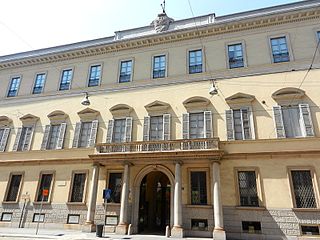
Palazzo Borromeo D’Adda, is an 18th-century palazzo in Milano. Historically belonging to the sestiere di Porta Nuova, it is located at via Manzoni no. 39/41.

Palazzo Recalcati is a 16th century palace in Milan, enlarged between the 17th and 18th centuries. Historically belonging to the district of Porta Ticinese, it is located in Via Amedei 8.





